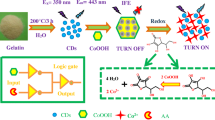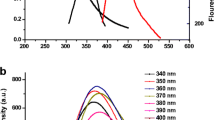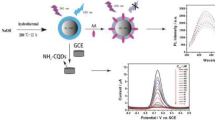Abstract
Herein, we first reported a facile synthesis method for fabrication of highly photoluminescent carbon quantum dots (CQDs) using sodium alginate as the carbon source and histidine as both the nitrogen source and functional monomer by one-pot hydrothermal synthesis. The as-prepared CQDs gave a high quantum yield of 32%. By employing the new CQDs and rhodamine B (RhB), we demonstrated a simple, facile, sensitive, and accurate ratiometric sensor for detection of Hg2+ and biological thiols. The photoluminescence of CQDs in the ratiometric sensor can be selectively and intensively suppressed by Hg2+ due to strong electrostatic interaction between the surface functional groups of the CQDs and Hg2+. When glutathione (GSH) was introduced into the “Turn Off” CQDs-RhB-Hg2+ sensing system, the fluorescence of the CQDs can be recovered rapidly due to the stronger affinity between thiol and Hg2+, while the fluorescence of the RhB remained constant in this sensing process. Based on the above principle, the ratiometric strategy for detecting Hg2+ and GSH can be achieved readily, and gives satisfactory limit of detections (LODs) of 30 and 20 nM for Hg2+ and GSH, respectively. The dual-emission fluorescent CQDs-RhB sensor does not need the complicated molecular design and the synthesis of dual-emission fluorophores. Meanwhile, the feasibility of the proposed method for analysis of water samples, food samples, and biological samples (plasma from mice oxidative stress study) was investigated. The developed ratiometric nanosensor is proven to be facile, with less sample consumption, rapid, lost cost, highly sensitive, and very selective for Hg2+ and biological thiol detection, which offers a new approach for environmental, food, and biological analysis.

Ratiometric nanosensing approach detection of Hg2+ and biological thiols







Similar content being viewed by others
References
Lim SY, Shen W, Gao Z. Carbon quantum dots and their applications. Chem Soc Rev. 2015;44:362–81.
Salinas-Castillo A, Morales DP, Lapresta-Fernández A, et al. Evaluation of a reconfigurable portable instrument for copper determination based on luminescent carbon dots. Anal Bioanal Chem. 2016;408:3013–20.
Fu Z, Li G, Hu Y. Chemiluminescence of nitrogen-rich quantum dots in diperiodatoargentate(III) solution and its application in ferulic acid analysis. Anal Bioanal Chem. 2016:1–8.
Lisdat F, Schäfer D, Kapp A. Quantum dots on electrodes—new tools for bioelectroanalysis. Anal Bioanal Chem. 2013;405:3739–52.
Gong P, Wang J, Hou K, et al. Small but strong: the influence of fluorine atoms on formation and performance of graphene quantum dots using a gradient F-sacrifice strategy. Carbon. 2017;112:63–71.
Lin VS, Chen W, Xian M, Chang CJ. Chemical probes for molecular imaging and detection of hydrogen sulfide and reactive sulfur species in biological systems. Chem Soc Rev. 2015;44:4596–618.
Mei J, Tong J, Wang J, et al. Discriminative fluorescence detection of cysteine, homocysteine and glutathione via reaction-dependent aggregation of fluorophore-analyte adducts. J Mater Chem. 2012;22(33):17063–70.
Park KS, Kim MI, Woo MA, et al. A label-free method for detecting biological thiols based on blocking of Hg 2+-quenching of fluorescent gold nanoclusters. Biosens Bioelectron. 2013;45:65–9.
Gu J, Hu D, Wang W, et al. Carbon dot cluster as an efficient “off–on” fluorescent probe to detect Au (III) and glutathione. Biosens Bioelectron. 2015;68:27–33.
Zhang L, Cai Q-Y, Li J, et al. A label-free method for detecting biothiols based on poly(thymine)-templated copper nanoparticles. Biosens Bioelectron. 2015;69:77–82.
Niu L-Y, Guan Y-S, Chen Y-Z, Wu L-Z, Tung C-H, Yang Q-Z. BODIPY-based ratiometric fluorescent sensor for highly selective detection of glutathione over cysteine and homocysteine. J Am Chem Soc. 2012;134:18928–31.
Zhang X-L, Zheng C, Guo S-S, Li J, Yang H-H, Chen G. Turn-on fluorescence sensor for intracellular imaging of glutathione using g-C3N4 Nanosheet–MnO2 sandwich nanocomposite. Anal Chem. 2014;86:3426–34.
Wang Y, Jiang K, Zhu J, Zhang L, Lin H. A FRET-based carbon dot–MnO2 nanosheet architecture for glutathione sensing in human whole blood samples. Chem Commun. 2015;51:12748–51.
Lee MH, Kim JS, Sessler JL. Small molecule-based ratiometric fluorescence probes for cations, anions, and biomolecules. Chem Soc Rev. 2015;44:4185–91.
Zhou X, Kwon Y, Kim G, Ryu J-H, Yoon J. A ratiometric fluorescent probe based on a coumarin–hemicyanine scaffold for sensitive and selective detection of endogenous peroxynitrite. Biosens Bioelectron. 2015;64:285–91.
Hou J, Dong J, Zhu H, Teng X, Ai S, Mang M. A simple and sensitive fluorescent sensor for methyl parathion based on l-tyrosine methyl ester functionalized carbon dots. Biosens Bioelectron. 2015;68:20–6.
Li G, Kong W, Zhao M, et al. A fluorescence resonance energy transfer (FRET) based “Turn-On” nanofluorescence sensor using a nitrogen-doped carbon dot-hexagonal cobalt oxyhydroxide nanosheet architecture and application to α-glucosidase inhibitor screening. Biosens Bioelectron. 2016;79:728–35.
Zhu A, Qu Q, Shao X, Kong B, Tian Y. Carbon-dot-based dual-emission nanohybrid produces a ratiometric fluorescent sensor for in vivo imaging of cellular copper ions. Angew Chem. 2012;124:7297–301.
Li G, Fu H, Chen X, et al. Facile and sensitive fluorescence sensing of alkaline phosphatase activity with photoluminescent carbon dots based on inner filter effect. Anal Chem. 2016;88(5):2720–6.
Purbia R, Paria S. A simple turn on fluorescent sensor for the selective detection of thiamine using coconut water derived luminescent carbon dots. Biosens Bioelectron. 2016;79:467–75.
Lan M, Zhang J, Chui Y-S, et al. Carbon nanoparticle-based ratiometric fluorescent sensor for detecting mercury ions in aqueous media and living cells. ACS Appl Mater Interfaces. 2014;6:21270–8.
Lan M, Zhang J, Chui Y-S, et al. A recyclable carbon nanoparticle-based fluorescent probe for highly selective and sensitive detection of mercapto biomolecules. J Mater Chem B. 2015;3:127–34.
Gupta A, Chaudhary A, Mehta P, et al. Nitrogen-doped, thiol-functionalized carbon dots for ultrasensitive Hg (II) detection. Chem Commun. 2015;51:10750–3.
Xu H, Hepel M. “Molecular beacon”-based fluorescent assay for selective detection of glutathione and cysteine. Anal Chem. 2011;83(3):813–9.
Jung HS, Chen X, Kim JS, et al. Recent progress in luminescent and colorimetric chemosensors for detection of thiols. Chem Soc Rev. 2013;42(14):6019–31.
Zhang N, Qu F, Luo HQ, Li NB. Sensitive and selective detection of biothiols based on target-induced agglomeration of silvernanoclusters. Biosens Bioelectron. 2013;42:214–8.
Cai Q-Y, Li J, Ge J, et al. A rapid fluorescence “switch-on” assay for glutathione detection by using carbon dots–MnO 2 nanocomposites. Biosens Bioelectron. 2015;72:31–6.
Han B, Yuan J, Wang E. Sensitive and selective sensor for biothiols in the cell based on the recovered fluorescence of the CdTe quantum dots—Hg (II) system. Anal Chem. 2009;81:5569–73.
Liu J, Bao C, Zhong X, Zhao C, Zhu L. Highly selective detection of glutathione using a quantum-dot-based OFF–ON fluorescent probe. Chem Commun. 2010;46:2971–3.
Xu Y, Niu X, Zhang H, et al. Switch-on fluorescence sensing of glutathione in food samples based on a graphitic carbon nitride quantum dot (g-CNQD)–Hg2+ chemosensor. J Agric Food Chem. 2015;63:1747–55.
Shi Y, Pan Y, Zhang H, et al. A dual-mode nanosensor based on carbon quantum dots and gold nanoparticles for discriminative detection of glutathione in human plasma [J]. Biosens Bioelectron. 2014;56:39–45.
Vedi M, Rasool M, Sabina EP. Amelioration of bromobenzene hepatotoxicity by Withania somnifera pretreatment: role of mitochondrial oxidative stress. Toxicol Rep. 2014;1:629–38.
Saha A, Jana NR. Detection of cellular glutathione and oxidized glutathione using magnetic–plasmonic nanocomposite-based “Turn-Off” surface enhanced raman scattering. Anal Chem. 2013;85:9221–8.
Acknowledgements
This work was supported by the National Natural Science Foundation of China (No. 21677085, 31301595, 21475074, 81303179, 21305076, and 21475075), the Project funded by China Postdoctoral Science Foundation (No. 2016M590071), The Natural Science Foundation of Shandong Province (ZR2013BQ019 and ZR2016EMB04), Project of Shandong Province Higher Educational Science and Technology Program (J16LA03), the National Science and Technology Support Program of China (No. 2015BAD16B02), and National Undergraduate Training Program for Innovation and Entrepreneurship (No. 201510446060). We also thank Dr. Shuwei Sun for his good advice in the preparation of N-doped carbon quantum dots.
Author information
Authors and Affiliations
Corresponding authors
Ethics declarations
Conflict of interest
The authors declare that they have no competing interests
Animal treatment
Kunming mice were obtained from animal house, China Biologic Products, Inc. This study was performed strictly according to the standards described in the “Guide for the Care and Use of Laboratory Animals” (National Research Council Commission on Life Sciences, 1996 edition). All animal treatment procedures were approved by the Animal Care Committee of Qufu Normal University, and all efforts were made to minimize suffering.
Additional information
Huili Fu and Zhongyin Ji contributed equally to this work.
Electronic supplementary material
Below is the link to the electronic supplementary material.
ESM 1
(PDF 268 kb)
Rights and permissions
About this article
Cite this article
Fu, H., Ji, Z., Chen, X. et al. A versatile ratiometric nanosensing approach for sensitive and accurate detection of Hg2+ and biological thiols based on new fluorescent carbon quantum dots. Anal Bioanal Chem 409, 2373–2382 (2017). https://doi.org/10.1007/s00216-017-0183-3
Received:
Revised:
Accepted:
Published:
Issue Date:
DOI: https://doi.org/10.1007/s00216-017-0183-3




